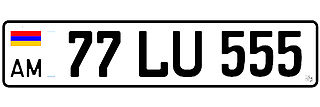
A vehicle registration plate, also known as a number plate or license plate or licence plate, is a metal or plastic plate attached to a motor vehicle or trailer for official identification purposes. All countries require registration plates for road vehicles such as cars, trucks, and motorcycles. Whether they are required for other vehicles, such as bicycles, boats, or tractors, may vary by jurisdiction. The registration identifier is a numeric or alphanumeric ID that uniquely identifies the vehicle or vehicle owner within the issuing region's vehicle register. In some countries, the identifier is unique within the entire country, while in others it is unique within a state or province. Whether the identifier is associated with a vehicle or a person also varies by issuing agency. There are also electronic license plates.

Vehicles registered in Slovakia were generally assigned to one of the districts (okres) and from 1997 until 2022, the license plate coding generally consisted of seven characters and takes the form XX-NNNLL, where XX was a two letter code corresponding to the district, NNN was a three digit number and LL were two additional letters.
The most common format for vehicle registration plates in Romania consists of black letters on white background in the format CC 12 ABC, where CC is a two letter county code, 12 is a two digit group, and ABC is a three letter group. For Bucharest, the format is B 12 ABC or B 123 ABC, where B is code for Bucharest city, 12 and 123 is a two or three digit group, and ABC is a three letter group. The left side of the plate bears a blue vertical strip displaying the 12 stars of the European Union and the country code of Romania (RO). Between 1992-2007 the band featured the Romanian flag instead of the 12 stars. All lettering comes from the Latin alphabet.
The Italian vehicle registration plates are the compulsory alphanumeric plates used to display the registration mark of motor vehicles registered in Italy. They have existed in the country since 1897.
Austrian car number plates are mandatory vehicle registration plates displaying the registration mark of motor vehicles in Austria. They are used to verify street legality, proof of a valid liability insurance and to identify and recognise the vehicle.

Vehicle license plates in the Philippines are issued and regulated by the Land Transportation Office, a government agency under the Department of Transportation (DOTr).
Vehicle registration plates of Poland indicate the region of registration of the vehicle given the number plate.
A vehicle registration plate, also known as a number plate, license plate or licence plate, is a metal or plastic plate or plates attached to a motor vehicle or trailer for official identification purposes. The registration identifier is a numeric or alphanumeric code that uniquely identifies the vehicle within the issuing authority's database. In Europe most countries have adopted a format for registration plates that satisfies the requirements in the Vienna Convention on Road Traffic, which states that cross-border vehicles must display a distinguishing code for the country of registration on the rear of the vehicle. This sign may be an oval sticker placed separately from the registration plate, or may be incorporated into the plate. When the distinguishing sign is incorporated into the registration plate, it must also appear on the front plate of the vehicle, and may be supplemented with the flag or emblem of the national state, or the emblem of the regional economic integration organisation to which the country belongs. An example of such format is the common EU format, with the EU flag above the country code issued in EU member states.
Vehicle registration plates of Serbia display black alphanumeric characters on a white background with blue field placed along the left side edge.

The FE-Schrift or Fälschungserschwerende Schrift is a sans serif typeface introduced for use on licence plates. Its monospaced letters and numbers are slightly disproportionate to prevent easy modification and to improve machine readability. The typeface was developed in Germany, where it has been mandatory since November 2000.
The Portuguese vehicle registration plate system for automobiles and motorcycles is simple and sequential. The system has no link to geographical locations or similar. It is an incremental numbering system consisting of three groups of two characters, separated by dashes. This system started in 1937 with AA–10–00, which ran out on 29 February 1992. This then went on to 00–01–AA and changed to 00–AA–01 in 2005. This last sequence was exhausted early in 2020, and it was announced on 3 March that it had been replaced by the sequence AA–00–AA. Moreover, the letters W and Y, never before used, and the letter K, used only for a short-lived series for imported vehicles in 1997, are being employed in the new system, meaning that this sequence should last more than six-and-a-half times as long as the previous. At current rates that it would not need replacing at least until the end of the 21st century, but the expected lifetime of the series is stated as being forty-five years.
In Albania, vehicle registration plates are issued by the General Directory of Road Transport Services.
Vehicle registration plates of Kosovo are issued by the Ministry of Internal Affairs of the Republic of Kosovo. As of June 1, 2012, all residents of Kosovo are obliged to fit their cars with KS or RKS plates. Non-compliance results in confiscation of the non-Kosovar plates and legal charges.

Since Ukraine's independence in 1991, the country has used four main systems of vehicle registration plates.
Vehicle registration plates of Estonia are divided into 18 categories, the most common of these (A1) is composed of three numbers and three letters. Most registration plate types have black letters on a white background, and the plates are the same size and length as other European plates. Previously the first of the three letters indicated the region of Estonia in which the car was registered; however, as of 2013, this is no longer the case. The third digit from the numbers indicated states when the car is due an inspection. It can be inspected up to 2 months after that digit. The registration plates are printed on an aluminium sheet with minimum thickness of 1 mm and must fulfil the requirements of ISO 7591:1982. All plates are issued with the blue European Union identification label, except types A9 and B2.

Standard license plates of Transnistria are 520 mm wide and 112 mm high, made of metal with 6 embossed characters - one letter, three numbers and two more letters - written using the DIN 1451 Mittelschrift font. On the left part of the plates there is also a modified euroband on a white background, having the flag of the PMR instead of the EU symbol. A holographic sticker in the place of the international country code underneath it was placed until 2015, when a law was revised, additionally removing black separation line between euroband and registration number; instead, two interpolated grey sine waves were added on the bottom of the plate. Government plates only have 5 embossed characters - three numbers and two letters. Only symbols that are common to both the Cyrillic and the Latin alphabets are used, and with their Cyrillic meaning. Its current design derives from Moldovan plates of 1992 design, but is slightly changed. Military plates are using Soviet design from 1959, and tractor plates are also using Soviet design, but from 1980.

Vehicle registration plates of Armenia have black characters on a rectangular white background. They are composed of two or three numbers, two letters in the middle, and two other numbers. At the left side is located the international code "AM" with an oval car plaque and, sometimes, the national flag. Starting from 6 August 2014 a new design of license plates was implemented. The license plates have a national flag on the left side, a security hologram and a machinery readable Data Matrix Code.
Vehicle registration plates are the alphanumeric plates used to display the registration mark of a vehicle, and have existed in the United Kingdom since 1904. It is compulsory for motor vehicles used on public roads to display vehicle registration plates, with the exception of vehicles of the reigning monarch used on official business.
Tajik vehicle registration plates are registration plates for vehicles registered in the country.
Turkmen registration plates were first issued in 1980, when the country was still a Soviet republic. Although it had become a sovereign state in 1991, Turkmenistan continued to use Soviet plates until the introduction of the current format in 1994 – a phenomenon also observed in Kyrgyzstan.










